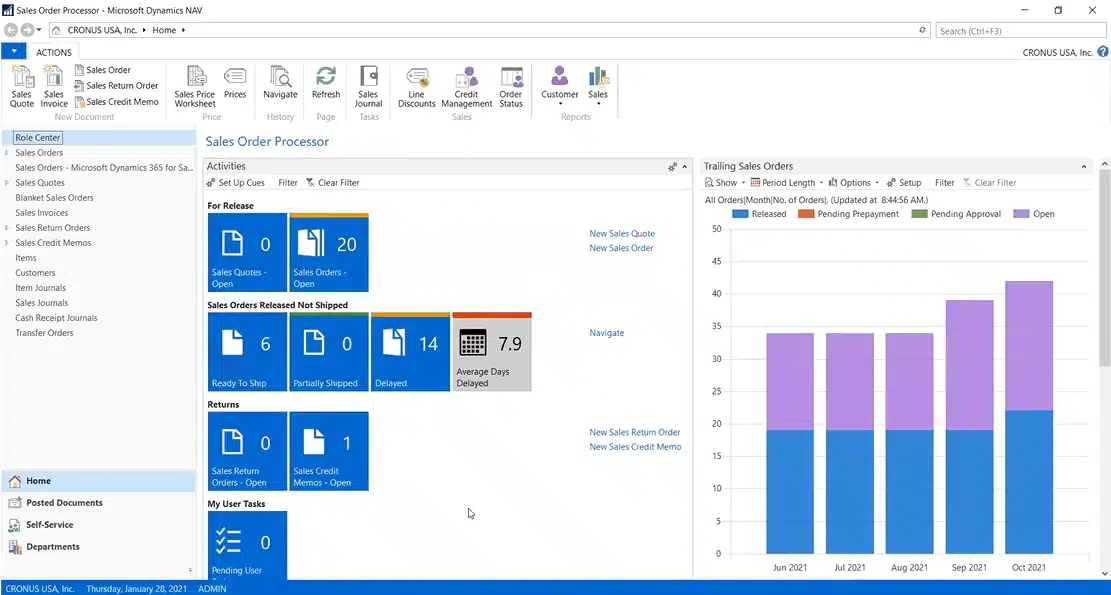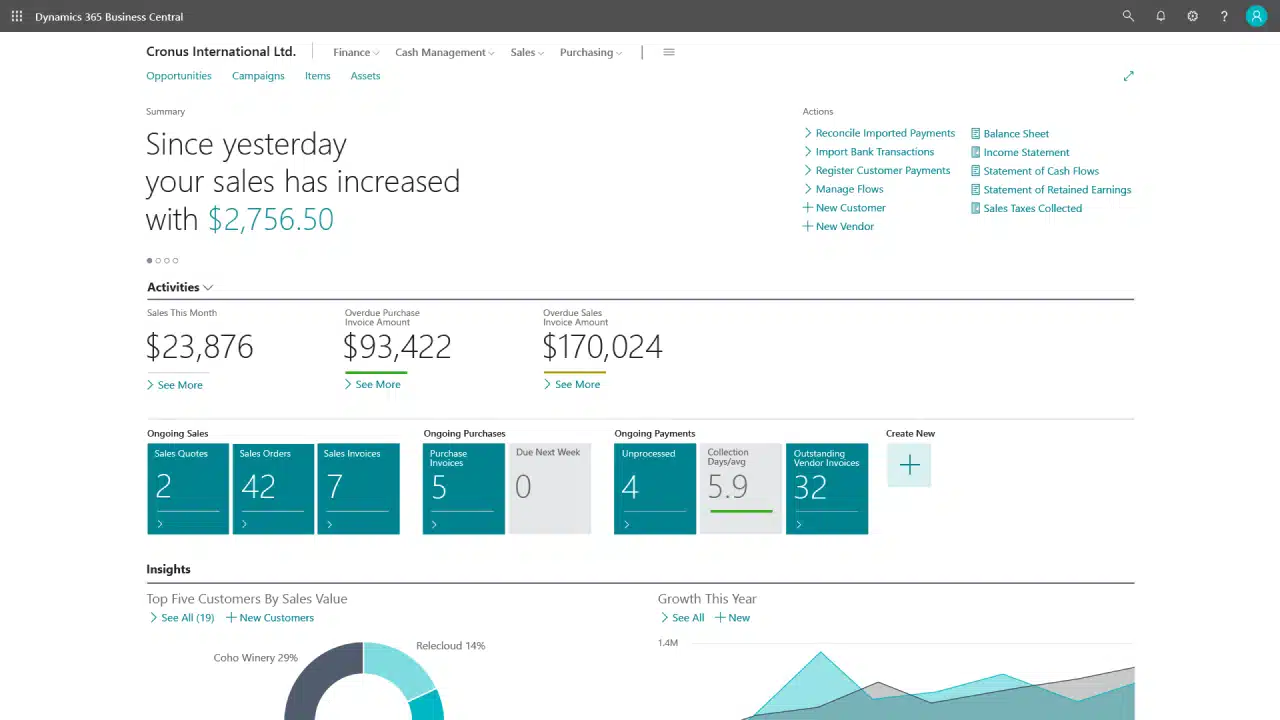Explore the key differences between Dynamics NAV and Business Central

Microsoft Dynamics NAV (formerly Navision) and Microsoft Dynamics 365 Business Central are two powerful enterprise resource planning (ERP) solutions designed to streamline business processes, improve operational efficiency, and drive growth. While Dynamics NAV served as a robust on-premise solution, Dynamics 365 Business Central represents its modern, cloud-based evolution, offering enhanced functionalities and seamless scalability.
As Microsoft transitioned from Dynamics NAV to the modern, cloud-based Dynamics 365 Business Central, understanding the key differences between these systems is crucial for decision-making aligned with long-term strategic goals. In this blog, we will explore the key differences between Dynamics NAV and Business Central to help you make an informed choice for your organization.
What is Dynamics NAV?
Microsoft Dynamics NAV, formerly known as Navision, is a comprehensive ERP software suite tailored for small to medium-sized businesses. Dynamics NAV stood out for its extensive range of features that covered various business processes, making it an invaluable tool for managing financials, supply chains, manufacturing, projects, and customer relationships. Additionally, Dynamics NAV iss a highly customizable system but the ability to change native source code makes the solution difficult to maintain and upgrade. Over the years, Dynamics NAV evolved through various iterations, each enhancing its capabilities and user experience.
However, it is important to note that Microsoft has decided to sunset Dynamics NAV. As of 2018, no new licenses for Dynamics NAV are being sold, and the focus has shifted towards its next-generation successor, Dynamics 365 Business Central. The last version of Dynamics NAV will receive security updates until 2028 and Microsoft will cease support completely thereafter. Additionally, the product is no longer receiving new feature updates or enhancements. Therefore, businesses currently using Dynamics NAV should consider migrating to a newer, modern solution that can better support their evolving needs and foster growth.
What is Business Central?
Microsoft Dynamics 365 Business Central (BC) is the next generation of Dynamics NAV, offering a modern, cloud-based ERP solution designed for small to medium-sized businesses SMBs. Building on the robust foundation of Dynamics NAV, BC includes all the functionality and business logic that was in Dynamics NAV and extends its capabilities with advanced features, enhanced usability, and seamless integration with other Microsoft services. As a comprehensive business management solution, BC provides the tools necessary to streamline operations, improve efficiency, and drive business growth
Dynamics 365 Business Central is positioned by Microsoft as the natural next step for users of legacy Dynamics products such as Dynamics NAV. It retains all the familiar functionalities of NAV while introducing new features and capabilities. This continuity ensures that NAV users can quickly adopt BC with minimal training. Additionally, Business Central includes enhancements such as tighter integration with the Microsoft stack, AI-driven insights, advanced cash flow management, and impressive workflow automation. Its modern, intuitive user interface further enhances usability and efficiency.
Business Central offers a wide range of capabilities, including:
- Financial management: General ledger, accounts payable, accounts receivable, cash management, and fixed asset management, with support for multiple currencies and advanced reporting.
- Supply chain management: Inventory management, purchase order processing, sales order management, and warehouse management.
- Manufacturing: Production order management, bill of materials (BOM) management, capacity planning, and quality control.
- Project management: Tools for effective planning, tracking, and managing of projects.
- Sales and service management: Seamless management of customer interactions, sales opportunities, and marketing campaigns.
Dynamics NAV vs Business Central: Key differences
For organizations currently utilizing Dynamics NAV and considering a migration to Dynamics 365 Business Central, understanding the differences between the two systems is essential. Dynamics NAV is an on-premise solution with a long history and robust functionality, while BC is its cloud-based successor, offering enhanced capabilities, seamless integrations, and modern user experiences.
One of the primary differences between Dynamics NAV and D365 BC lies in their deployment models. Dynamics NAV is primarily on-premises, requiring significant infrastructure and maintenance, whereas Business Central can be deployed both on-premises and in the cloud, providing flexibility, accessibility, and scalability to meet diverse organizational needs. This difference in deployment options impacts not only the initial implementation process but also ongoing maintenance, updates, and support.
Dynamics 365 Business Central is a cloud-based ERP solution that builds upon the strengths of Dynamics NAV while addressing its limitations. BC offers the same core functionalities as NAV but enhances them with modern capabilities such as real-time data access, AI-driven insights with D365 Copilot, and seamless integration with the broader Microsoft ecosystem, including Microsoft 365 and Power BI. It provides scalability, allowing businesses to grow without the need for extensive on-premises infrastructure. Regular updates from Microsoft ensure that users always have access to the latest features and security enhancements, reducing the overhead associated with system maintenance.
The table below provides a high-level overview of the primary differences between the two systems.
Why migrate from Dynamics NAV to Business Central?
Microsoft has discontinued Dynamics NAV and replaced it with Dynamics 365 Business Central. This means that Dynamics NAV will no longer receive updates and hotfixes from Microsoft. Because of this, Dynamics NAV will gradually become outdated, reliant on old technology, and harder to use. Dynamics NAV users can migrate to Business Central which provides the same core functionalities in a modern, cloud-based solution that enhances user experience.
Key reasons to migrate:
- Cost efficiency and subscription model: Dynamics NAV requires significant investments in infrastructure and maintenance. Business Central operates on a subscription-based model, offering lower ongoing costs compared to NAV. Businesses using Dynamics NAV face annual maintenance fees, infrastructure costs, costly upgrades, and database maintenance costs, while Business Central’s subscription pricing is all-inclusive, resulting in a lower total cost of ownership (TCO) than Dynamics NAV.
- Enhanced features and functionalities: Business Central builds upon the foundation of Dynamics NAV, retaining its core functionalities while introducing modern features such as AI-driven insights, predictive analytics, and advanced reporting capabilities. These enhancements empower businesses to make informed decisions faster and optimize their operations more effectively.
- Future-proof solution with regular updates: Microsoft’s roadmap for Business Central includes regular updates and innovations, ensuring that businesses always have access to the latest features, security patches, and compliance updates.
- Cloud capabilities and remote access: Being cloud-based, Business Central supports remote work and collaboration by enabling secure access from anywhere, on any device. This flexibility enhances productivity and agility.
- Improved security and compliance: Microsoft’s cloud infrastructure ensures robust security measures, including data encryption, access controls, and compliance with GDPR, SOC, and ISO standards. Migrating to Business Central enhances data protection and reduces regulatory risks.
- Seamless integration: Business Central integrates seamlessly with other Microsoft products and services, including Microsoft 365 and the Power Platform. This integration creates a unified ecosystem where data flows seamlessly between applications, enhancing productivity, collaboration, and business intelligence capabilities.
- Modern user experience: Business Central offers a modern and intuitive user interface designed to improve user adoption and productivity. Its user-friendly design reduces training time and enhances user satisfaction.
By migrating from Dynamics NAV to Dynamics 365 Business Central, organizations can leverage a modern ERP solution that not only addresses current operational challenges but also prepares them for future growth and innovation.
Migrate from Dynamics NAV to Business Central with Rand Group
At Rand Group, we understand that migrating from Dynamics NAV to Business Central is a significant decision that requires careful planning and execution. Our team of experienced consultants is here to guide you through every step of the migration process, ensuring a seamless transition and maximizing the benefits of your new ERP solution. As experts in both systems, Rand Group offers comprehensive migration services to help clients transition smoothly, ensuring minimal disruption to your business operations while maximizing the benefits of the new platform.
Our services include:
- Evaluation and requirements gathering: We work closely with your team to assess your business needs and evaluate whether Dynamics 365 Business Central is the right fit for your organization. Our comprehensive assessment ensures that your new system will align perfectly with your strategic goals.
- Customization and integration: Our experts customize the Business Central solution to align with your specific requirements and integrate it seamlessly with the rest of your technology stack.
- Data Migration: Our team assists in migrating your data from Dynamics NAV to Business Central, ensuring accuracy and minimal disruption to your operations. We use proven methodologies to ensure data integrity and continuity.
- Configuration and implementation: We configure and implement Business Central according to best practices, optimizing its functionality to meet your business objectives and drive efficiency. Our implementation process is designed to ensure that your new system is up and running smoothly and quickly.
- Post-go-live Support: We provide ongoing support and training to help your team adapt to the new system and maximize its potential. Our support services ensure a smooth transition and continued success.
Next steps
Understanding the key differences between Dynamics NAV and Dynamics 365 Business Central is crucial for organizations considering a migration. While Dynamics NAV has been a reliable ERP solution for many years, Business Central offers a modern, cloud-based alternative with enhanced capabilities, seamless integrations, and a user-friendly interface. The migration from NAV to Business Central not only addresses the limitations of legacy systems but also provides businesses with the tools needed for future growth and innovation.
Ready to take the next step? Contact us today to learn more about how Rand Group can help you migrate from Dynamics NAV to Dynamics 365 Business Central and unlock the full potential of your ERP solution.






